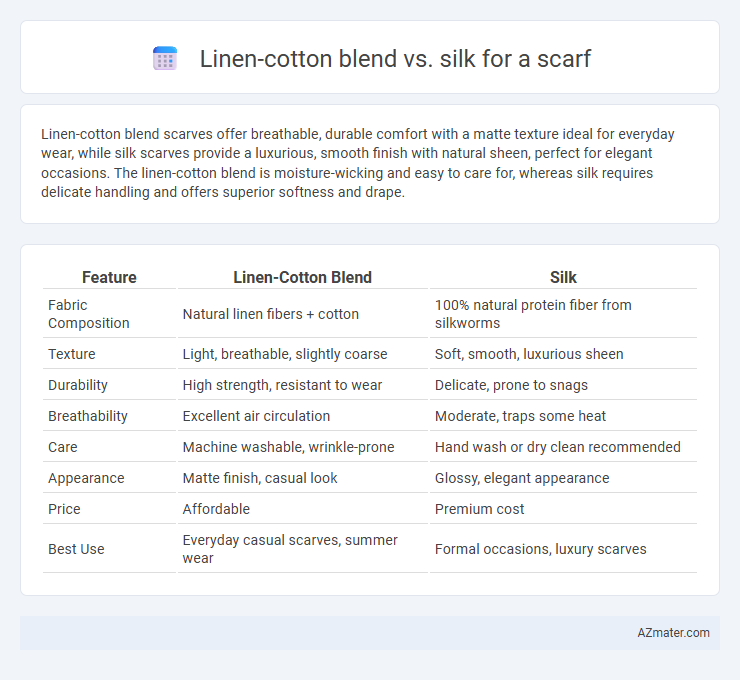Linen-cotton blend scarves offer breathable, durable comfort with a matte texture ideal for everyday wear, while silk scarves provide a luxurious, smooth finish with natural sheen, perfect for elegant occasions. The linen-cotton blend is moisture-wicking and easy to care for, whereas silk requires delicate handling and offers superior softness and drape.
Table of Comparison
| Feature | Linen-Cotton Blend | Silk |
|---|---|---|
| Fabric Composition | Natural linen fibers + cotton | 100% natural protein fiber from silkworms |
| Texture | Light, breathable, slightly coarse | Soft, smooth, luxurious sheen |
| Durability | High strength, resistant to wear | Delicate, prone to snags |
| Breathability | Excellent air circulation | Moderate, traps some heat |
| Care | Machine washable, wrinkle-prone | Hand wash or dry clean recommended |
| Appearance | Matte finish, casual look | Glossy, elegant appearance |
| Price | Affordable | Premium cost |
| Best Use | Everyday casual scarves, summer wear | Formal occasions, luxury scarves |
Introduction: Comparing Linen-Cotton Blend and Silk Scarves
Linen-cotton blend scarves offer durability, breathability, and a matte texture ideal for casual and everyday wear, while silk scarves boast a smooth, lustrous finish and natural sheen suited for formal occasions. The linen-cotton fabric combines natural fibers that enhance moisture-wicking and softness, contrasting with silk's lightweight and hypoallergenic properties. Choosing between these materials depends on preferences for texture, maintenance, and climate suitability.
Material Composition: Linen-Cotton Blend vs Silk
Linen-cotton blend scarves offer a balanced combination of natural fibers, providing breathability, durability, and a slightly textured feel ideal for everyday wear. Silk scarves feature a smooth, luxurious texture with a natural sheen, known for excellent drape and lightweight softness that enhances elegance. The linen-cotton blend's moisture-wicking and wrinkle-resistant properties contrast with silk's hypoallergenic and temperature-regulating qualities, influencing scarf choice based on comfort and aesthetic preferences.
Texture and Comfort: Which Feels Better?
Linen-cotton blend scarves offer a breathable, slightly textured feel that softens with wear, providing lightweight comfort ideal for warmer weather. Silk scarves feature a smooth, luxurious texture with a natural sheen, delivering a cool, gentle touch against the skin that feels silky and elegant. For those prioritizing softness and smoothness, silk feels better, while a linen-cotton blend suits individuals seeking a casual, airy, and textured comfort.
Breathability and Climate Suitability
Linen-cotton blend scarves offer superior breathability due to the natural fibers' moisture-wicking properties, making them ideal for warm and humid climates. Silk scarves, while lightweight and smooth, trap heat more easily and perform better in mild to cooler weather by providing gentle insulation. Choosing between the two depends on the need for airflow and temperature regulation, with linen-cotton blends excelling in hot conditions and silk offering comfort in transitional or cooler environments.
Durability and Longevity
Linen-cotton blend scarves offer superior durability due to their strong fibers and resistance to wear, making them ideal for everyday use. Silk scarves, while luxurious and smooth, are more delicate and prone to snags and fading, requiring careful handling to maintain longevity. The durability of linen-cotton blends generally ensures longer-lasting scarves compared to the fragile nature of silk.
Style and Aesthetic Appeal
Linen-cotton blend scarves offer a casual, textured look with natural matte finishes that complement effortless, everyday styles. Silk scarves provide a luxurious sheen and smooth drape, enhancing formal and elegant outfits with vibrant colors and intricate patterns. The choice between linen-cotton and silk scarves significantly influences the overall aesthetic, balancing comfort and sophistication.
Care and Maintenance Requirements
Linen-cotton blend scarves require gentle hand washing with mild detergent and should be air-dried flat to prevent shrinking and fabric distortion. Silk scarves demand extra care, including dry cleaning or delicate hand washing with cold water and specialized silk detergent to preserve their softness and sheen. Both fabrics benefit from low-heat ironing on the reverse side, but silk's delicate fibers necessitate more cautious handling to avoid damage.
Eco-Friendliness and Sustainability
Linen-cotton blend scarves offer significant eco-friendliness due to their natural fibers, biodegradability, and lower water and energy consumption during production compared to silk. Silk production involves intensive resource use and often relies on sericulture practices that may impact ecosystems, whereas linen and cotton from organic sources promote sustainable farming with reduced chemical inputs. Opting for linen-cotton blend scarves supports sustainability through durable, renewable materials that minimize environmental footprint and are easier to recycle or compost at end-of-life.
Price and Value Comparison
Linen-cotton blend scarves typically offer a budget-friendly option, combining durability and breathability with a soft texture, making them ideal for everyday wear. Silk scarves, while significantly more expensive due to their luxurious feel and natural sheen, provide superior elegance and drape, often viewed as a long-term investment in style. Comparing price and value, linen-cotton blends deliver affordability and practicality, whereas silk scarves emphasize premium quality and aesthetic appeal, justifying their higher cost for formal occasions.
Conclusion: Choosing the Best Scarf Material for You
Linen-cotton blend scarves offer durability, breathability, and easy maintenance, making them ideal for daily wear and warmer climates. Silk scarves provide a luxurious feel, natural sheen, and hypoallergenic properties, perfect for formal occasions and sensitive skin. Prioritize your lifestyle, climate, and care preferences to select the scarf material that best suits your needs.

Infographic: Linen-cotton blend vs Silk for Scarf
 azmater.com
azmater.com